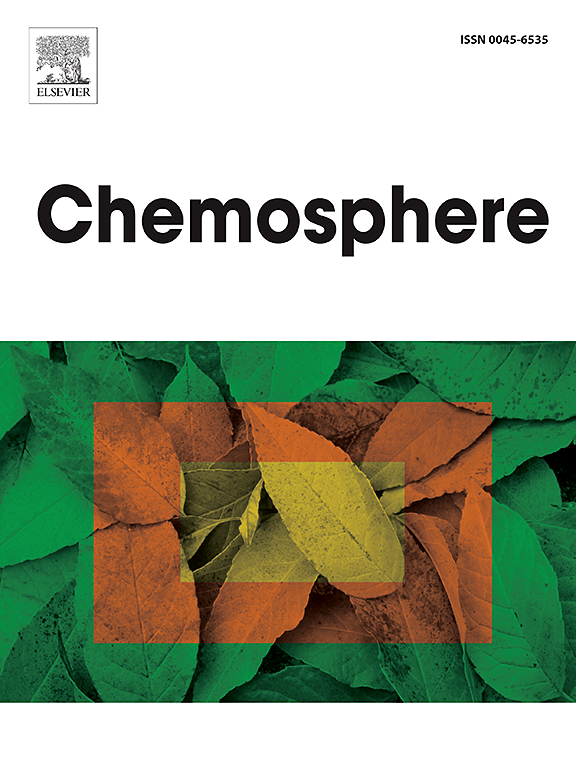新型杀虫剂和植物油对土壤中非目标生物的生态毒理学效应和风险
IF 8.1
2区 环境科学与生态学
Q1 ENVIRONMENTAL SCIENCES
引用次数: 0
摘要
施用杀虫剂是主要用于防治害虫的策略,特别是在大豆等单一栽培作物中。人们对开发更高效、更环保、更靶向的活性物质(a.s)的需求越来越大,比如诺伐脲(novaluron),它是一种抑制几丁质合成的昆虫生长调节剂。一些害虫,如秋粘虫,已经成功地对抗了使用多效杀虫剂组成的新valuron和灭多威。此外,在使用这些植物保护产品(PPPs)之前,如果将植物油等佐剂混合,则可以更有效地使用这些产品。然而,人们对以新valun为基础的杀虫剂和佐剂植物油所造成的风险,即对土壤非目标生物所造成的风险缺乏了解。为了填补这一知识空白,按照标准指南,对PPPs环境风险评估数据要求中考虑的土壤非目标无脊椎动物,即蚯蚓Eisenia andrei、线虫Folsomia candida、掠食性螨Hypoaspis aculeifer进行了实验室繁殖试验。利用毒性暴露比(TER)对大豆作物单次施用的风险进行了估计。含有植物油(Veget 'Oil®)和新伐能龙(Rimon®100 EC)的测试配方对所有测试物种都没有风险,但含有新伐能龙+灭多威(Voraz®)的测试配方对所有物种都有风险。结果表明,当新valuron与其他杀虫剂联合使用时,新valuron杀虫剂的毒性更相关。此外,即使新valuron杀虫剂的风险较低,也应引起关注,因为它们在土壤中具有相当的持久性。本文章由计算机程序翻译,如有差异,请以英文原文为准。

Ecotoxicological effects and risk of novaluron-based insecticides and vegetable oil to non-target in-soil organisms
Insecticide application is the strategy mostly used to combat insect pests, especially in monocultures like soybean. There is an increasing demand for the development of more efficient, eco-friendly, and target-specific active substances (a.s.), like novaluron, which is an insect growth regulator acting in the inhibition of chitin synthesis. Several insect pests, like the fall armyworm, have been successfully combated using multi a.s. pesticides composed of novaluron and methomyl. Moreover, the application of these Plant Protection Products (PPPs) can be more efficient when adjuvants, like vegetable oil, are mixed before their application. However, there is a lack of knowledge about the risk posed by novaluron-based insecticides and the adjuvant vegetable oil, namely for soil non-target organisms. Aiming to fill this knowledge gap, laboratory reproduction tests were performed with the soil non-target invertebrate species considered in the data requirements for PPPs environmental risk assessment, i.e., the earthworm Eisenia andrei, the collembola Folsomia candida, the predatory mite Hypoaspis aculeifer, following standard guidelines. The toxicity-exposure ratio (TER) was used to estimate the risk based on a single application for soybean crops. Tested formulations with vegetable oil (Veget’Oil®) and novaluron (Rimon® 100 EC) presented no risk for all tested species, but the one with novaluron + methomyl (Voraz®) evidenced risk for all of them. Results indicate that the toxicity of novaluron-based insecticides can be more relevant when novaluron is combined with other a.s. Moreover, even when the risk of the novaluron pesticides is low, they should be seen with concern due to their considerable persistence in soil.
求助全文
通过发布文献求助,成功后即可免费获取论文全文。
去求助
来源期刊

Chemosphere
环境科学-环境科学
CiteScore
15.80
自引率
8.00%
发文量
4975
审稿时长
3.4 months
期刊介绍:
Chemosphere, being an international multidisciplinary journal, is dedicated to publishing original communications and review articles on chemicals in the environment. The scope covers a wide range of topics, including the identification, quantification, behavior, fate, toxicology, treatment, and remediation of chemicals in the bio-, hydro-, litho-, and atmosphere, ensuring the broad dissemination of research in this field.
 求助内容:
求助内容: 应助结果提醒方式:
应助结果提醒方式:


